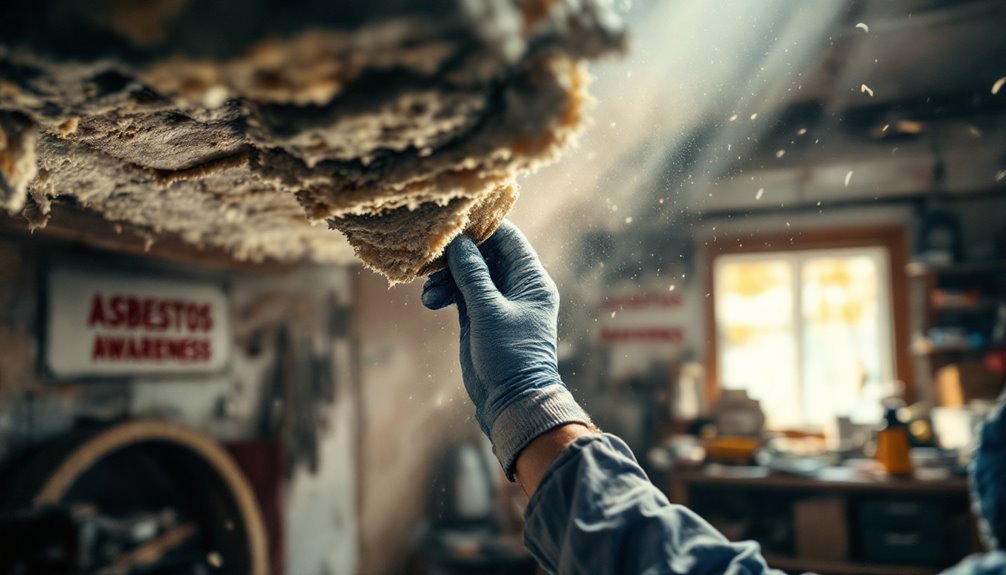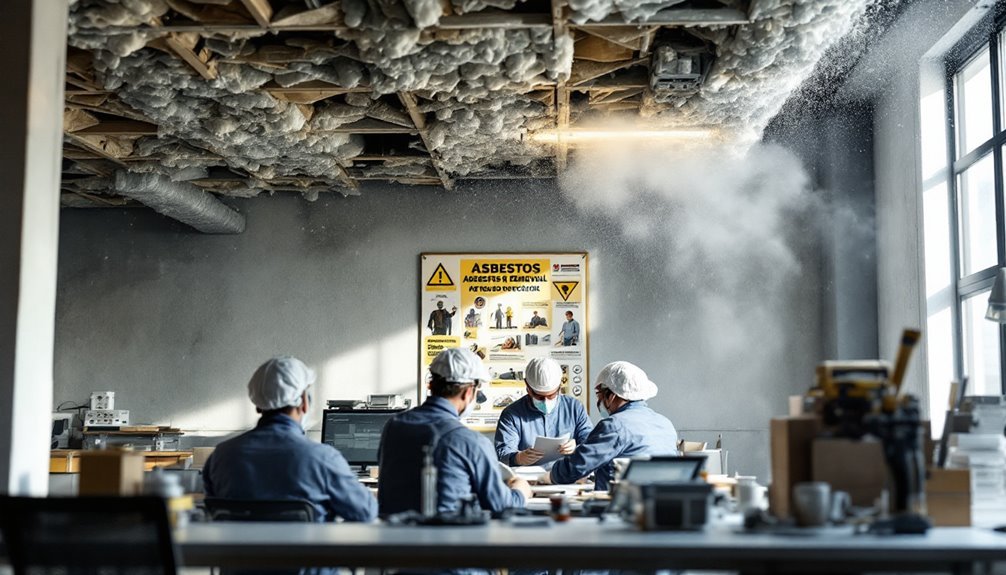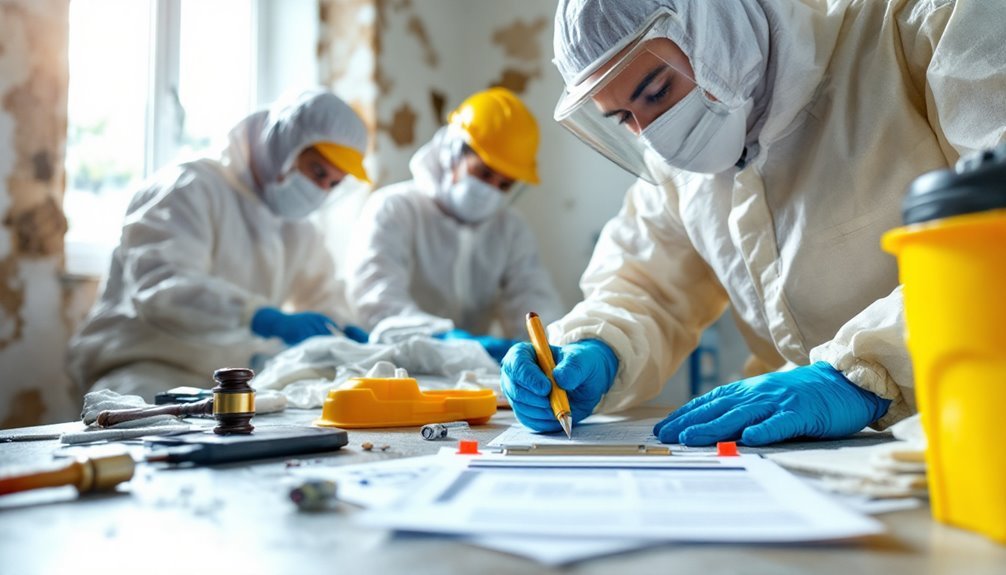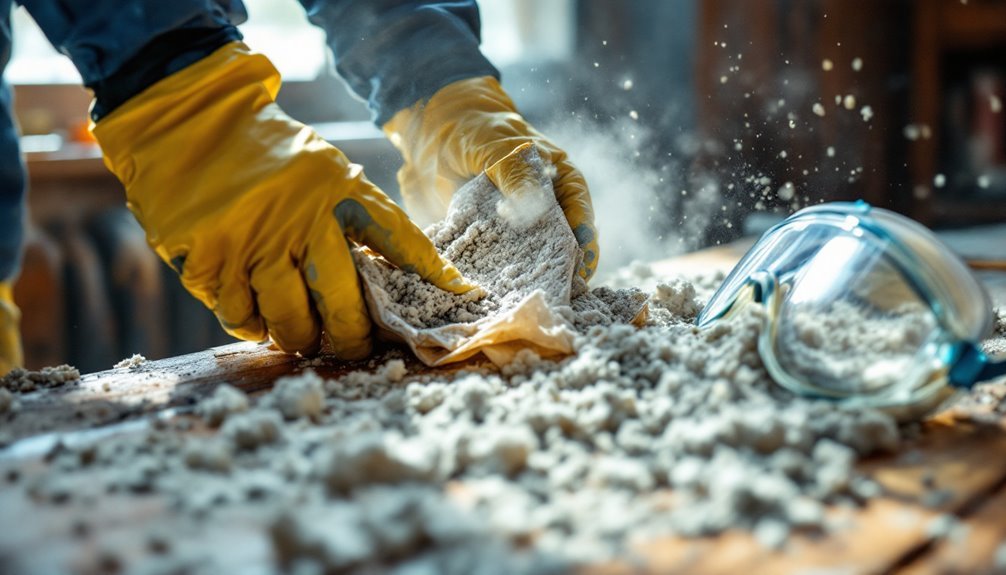Before starting asbestos removal, you need to separate fact from fiction. Not all asbestos is similarly hazardous, but improper handling can lead to serious health risks like lung cancer. DIY removal seems easy, but it's complex and dangerous; hiring professionals is crucial for safe and compliant removal. You should likewise be aware of local regulations regarding notification and proper disposal. Costs vary widely, so getting multiple quotes helps guarantee fair pricing. Understanding these aspects will guide you in making informed choices as you navigate the asbestos removal process. There's more to uncover about this significant subject.
Common Misconceptions About Asbestos

When it comes to asbestos, a cloud of misconceptions often obscures the facts. Many people believe all asbestos types are similarly harmful, but that's not entirely true. While all forms of asbestos can pose health risks, some, like chrysotile, are less hazardous than others, particularly when undisturbed. Misunderstanding the types can lead to unnecessary panic and misguided removal strategies.
Another common myth is that simply sealing asbestos is a viable solution. In reality, effective removal techniques depend on the specific situation. Encapsulation might be suitable for certain cases, but it's not a substitute for professional removal when asbestos is damaged or at risk of release. You can't ignore the importance of proper assessment and the right approach.
Additionally, many assume that DIY removal is straightforward and safe. On the contrary, the complexities involved in handling different asbestos types require specialized knowledge and equipment. Trusting professionals guarantees that removal techniques are executed correctly, minimizing health risks for you and your community.
DIY Removal Risks
The allure of DIY projects can be tempting, but tackling asbestos removal yourself poses significant risks that shouldn't be underestimated. Asbestos exposure is linked to serious health issues, including lung cancer and mesothelioma. Even minimal exposure can have long-term consequences, making it vital to understand these risks before considering DIY removal.
First, many underestimate the complexity of safely removing asbestos. Proper techniques are fundamental to prevent fibers from becoming airborne. If you're not trained, you might inadvertently spread asbestos, increasing health risks for yourself and others. Safety precautions, such as using appropriate protective gear and containment methods, are often overlooked in DIY removal scenarios.
Moreover, local regulations may require professional handling of asbestos materials. Ignoring these laws can lead to fines and legal issues. The equipment and materials necessary for safe removal can similarly be costly and challenging to source.
Ultimately, while the desire for independence and cost savings is understandable, the potential dangers of DIY asbestos removal far outweigh the benefits. Investing in professional help guarantees not only your safety but likewise compliance with regulations, allowing you to reclaim your space without jeopardizing your health.
Importance of Professional Services

Many homeowners overlook the critical importance of hiring professional services for asbestos removal. You might think that tackling this hazardous material yourself could save you money, but the risks far outweigh the benefits. Professional expertise is crucial when dealing with asbestos, as trained specialists understand not just the material itself, but the complexities of safe removal practices.
Asbestos fibers are highly dangerous when disturbed, and improper handling can release them into the air, creating health hazards for you and your family. Professionals use advanced techniques and equipment to guarantee the safe containment and disposal of asbestos, protecting both your home and the surrounding environment. Their knowledge of regulations and industry standards guarantees compliance, preventing potential legal issues or costly fines.
Asbestos Testing Procedures
Asbestos testing procedures are vital for identifying the presence of this hazardous material in your home. You can't just rely on visual inspection; accurate testing is fundamental for your safety. Various asbestos sampling techniques are employed, each with its own level of testing accuracy. Here's a breakdown of common methods:
| Sampling Technique | Description |
|---|---|
| Bulk Sampling | Collecting materials suspected of containing asbestos for lab testing. |
| Air Sampling | Measuring airborne asbestos fibers in your environment. |
| Tape or Swab Sampling | Using adhesive tape to capture surface dust for analysis. |
| PCM vs. TEM Analysis | Polarized light microscopy (PCM) is quicker, while transmission electron microscopy (TEM) offers more detailed results. |
Before you start, remember to wear protective gear and follow safety protocols. If you're uncertain about the process, hiring a certified professional can guarantee that the sampling is done correctly, maximizing testing accuracy. Don't take chances with your health; knowing the right asbestos testing procedures empowers you to make knowledgeable choices about your living space.
Legal Regulations and Compliance

Steering through the legal environment surrounding asbestos removal can feel overwhelming, but understanding the regulations is vital for guaranteeing compliance and safety. You must be aware of your legal obligations, as failure to adhere to these compliance requirements can lead to serious consequences, including hefty fines or even criminal charges.
Here are three key points to reflect on:
- Licensing: Verify your contractor is licensed and certified for asbestos removal. This assures they understand compliance requirements and have the necessary training.
- Notification: You're often required to notify local authorities before any asbestos removal project. This step is important for compliance and helps guarantee public safety.
- Disposal: Proper disposal of asbestos waste is a legal obligation. Make sure your contractor follows local regulations regarding the handling and disposal of hazardous materials.
Navigating these legal obligations might seem challenging, but staying informed empowers you to take control of the process. Complying with these regulations not only protects you but also contributes to a safer environment for your community.
Cost Considerations
Understanding the legal regulations around asbestos removal is just one part of the equation; the financial implications likewise play a significant role in your decision-making process. As you navigate through this vital task, it's important to engage in thorough budget planning. Removal expenses can vary widely based on several factors, including the size of the area, the type of asbestos present, and the complexity of the removal process.
Before you start, obtain multiple quotes from licensed professionals. This allows you to compare costs and services, ensuring you choose a reliable contractor without overspending. Keep in mind that while opting for the cheapest option may seem appealing, it could lead to inadequate removal, resulting in higher costs down the line because of potential rework or health risks.
Factor in extra expenses such as waste disposal, air quality testing, and any necessary renovations post-removal. These costs can add up quickly, making it vital to maintain a clear perspective on your budget. By planning wisely, you can safeguard your financial freedom while ensuring a safe environment for yourself and your loved ones.
Health Risks of Asbestos Exposure

Exposure to asbestos can pose serious health risks that you shouldn't take lightly. Even minimal contact can lead to severe consequences over time. It's vital to understand the potential asbestos symptoms and the long-term effects they can have on your health.
Here are three key health risks associated with asbestos exposure:
- Asbestosis: This chronic lung condition results from inhaling asbestos fibers, leading to scarring and inflammation of lung tissue. Symptoms include shortness of breath and persistent cough.
- Mesothelioma: This aggressive cancer primarily affects the lining of the lungs and abdomen. Mesothelioma has a long latency period, often remaining undetected for decades before symptoms manifest, such as chest pain and difficulty breathing.
- Lung Cancer: Exposure to asbestos greatly increases the risk of lung cancer, especially for smokers. Asbestos symptoms may include coughing, chest discomfort, and unexplained weight loss.
Being aware of these risks is fundamental. If you suspect asbestos in your environment, prioritize safe removal practices to protect yourself and your loved ones from these life-threatening health issues. Remember, prevention is always better than cure.
Conclusion
Understanding the myths surrounding asbestos removal is essential before diving into the process. While it might seem tempting to tackle it yourself, the risks are akin to trying to fix a vintage car without a mechanic's expertise. Prioritize professional services to guarantee safety and compliance with regulations. Remember, the health risks of asbestos exposure are real and serious. Don't take shortcuts; invest in proper testing and removal to protect yourself and your loved ones.
